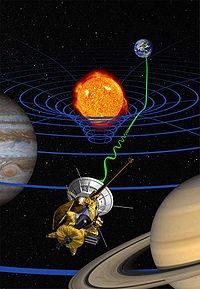
Photo from wikipedia
The observation of GW170817 in both gravitational and electromagnetic waves provides a number of unique tests of general relativity. Certain modifications of gravity involve the presence of additional spacetime dimensions.… Click to show full abstract
The observation of GW170817 in both gravitational and electromagnetic waves provides a number of unique tests of general relativity. Certain modifications of gravity involve the presence of additional spacetime dimensions. In these models, as the gravitational waves propagate they "leak" into the extra dimensions, leading to a reduction in the amplitude of the observed gravitational waves, and a commensurate systematic error in the inferred distance to the gravitational wave source. Electromagnetic waves would remain unaffected. We compare the inferred distance to GW170817 from the observation of gravitational waves, $d_L^\mathrm{GW}$, with the inferred distance to the electromagnetic counterpart NGC 4993, $d_L^\mathrm{EM}$. We constrain $d_L^\mathrm{GW} = (d_L^\mathrm{EM})^\mathrm{\gamma}$ with $\gamma = 1.01^{+0.04}_{-0.05}$ (for the SHoES value of $H_0$) or $\gamma = 0.99^{+0.03}_{-0.05}$ (for the Planck value of $H_0$), where all values are MAP and minimal 68\% credible intervals. These constraints imply that gravitational waves propagate in $D=3+1$ spacetime dimensions, as expected in general relativity. In particular, we find that $D = 4.02^{+0.07}_{-0.10}$ (SHoES) and $D = 3.98^{+0.07}_{-0.09}$ (Planck). Furthermore, we place limits on the screening scale for theories with $D>4$ spacetime dimensions, finding that the screening scale must be greater than $\sim 20\,$Mpc. We also place a lower limit on the lifetime of the graviton of $t > 4.50 \times 10^8\,$yr.
Journal Title: Journal of Cosmology and Astroparticle Physics
Year Published: 2018
Link to full text (if available)
Share on Social Media: Sign Up to like & get
recommendations!